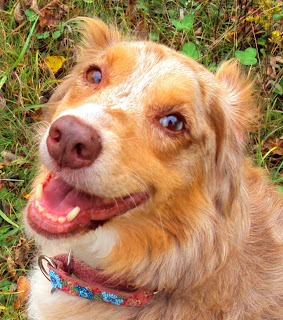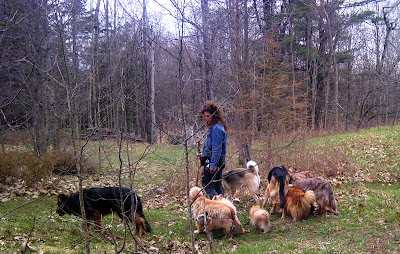DOGS AND SEPARATION ANXIETY
WHAT IS SEPARATION ANXIETY?
When a dog
experiences anxiety upon being separated from it’s companions - in this case we
will assume ‘companions’ refers to the dog’s humans. Separation anxiety is a psychological condition.
CAN SEPARATION ANXIETY BY TREATED/CURED BY DRUGS (SSRIS)?
The answer is NO! I do NOT recommend the use of anti-depressant SSRIS (i.e. Reconcile) for dogs. Reconcile is actually Prozac. Prozac/Reconcile:
CAN SEPARATION ANXIETY BY TREATED/CURED BY DRUGS (SSRIS)?
The answer is NO! I do NOT recommend the use of anti-depressant SSRIS (i.e. Reconcile) for dogs. Reconcile is actually Prozac. Prozac/Reconcile:
- Will NOT cure separation anxiety, or any other anxiety for that matter;
- Has many and serious, including lethal side effects;
- Actually induces many of the symptoms of anxiety, and;
- Can make the anxiety a heightened and chronic condition.
Separation Anxiety can be Summarized as Follows...
- The Root Cause of separation anxiety is insecurity;
- Provocation can be immediate or accumulated;
- The Source of the provocation is predominantly caused by inadvertent human-based influence;
- However the condition may also be triggered and/or exacerbated by a sudden traumatic event or an event in tandem with human-based influence;
- The Result of provocation without proper intervention is a destabilized physiological state - 'an altered normal' which when addressed properly can be reversed.
IS SEPARATION ANXIETY EXPERIENCED BY
ALL DOGS IN THE SAME WAY?
No, just as we humans react in various
ways to stressors, so too do dogs. If
your dog has separation anxiety he may have a very mild case of anxiety and
just gets into little things like tissue boxes…or if the anxiety is more severe
may destroy couches, walls, crates. Dogs with extreme anxiety can really harm
themselves as they chew on things that can cut their mouths, or they may get tangled
and trapped trying to escape confinement.
CAN THE BEHAVIOUR GO FROM MILD TO
EXTREME?
Yes, if left
untreated the behaviour can escalate over time. Depending on the dog, escalation
may be slow, for others dogs it may occur rapidly.
SYMPTOMS DON'T USUALLY EXIST IN ISOLATION
Separation Anxiety is usually a symptom of a bigger issue...
- the issue for the dog is usually insecurity;
- enabled (unintentionally) by lack of leadership from the human.
Usually symptoms do not exist in isolation but are fed and supported by other symptoms. Treating an issue really requires a holistic approach. A dog usually has other symptoms, for example, exhibits nervousness, fear when encountering:
- garbage bags;
- construction vehicles;
- flags;
- loud noises, etc.;
In order to successfully eradicate the issue (insecurity), all of the symptoms must be addressed. I never allow a dog to flee or avoid something that they fear. With patience, calm confidence, respect, understanding, determination and persistence I coach and mentor the dog through each and every situation. In so doing I ensure that the dog leaves each situation it (formerly feared) with a new association - an understanding that it is safe and will not be harmed. By employing this methodology the dog learns confidence, over time insecurity fades away...and so to do the symptoms of insecurity.
SYMPTOMS DON'T USUALLY EXIST IN ISOLATION
Separation Anxiety is usually a symptom of a bigger issue...
- the issue for the dog is usually insecurity;
- enabled (unintentionally) by lack of leadership from the human.
Usually symptoms do not exist in isolation but are fed and supported by other symptoms. Treating an issue really requires a holistic approach. A dog usually has other symptoms, for example, exhibits nervousness, fear when encountering:
- garbage bags;
- construction vehicles;
- flags;
- loud noises, etc.;
In order to successfully eradicate the issue (insecurity), all of the symptoms must be addressed. I never allow a dog to flee or avoid something that they fear. With patience, calm confidence, respect, understanding, determination and persistence I coach and mentor the dog through each and every situation. In so doing I ensure that the dog leaves each situation it (formerly feared) with a new association - an understanding that it is safe and will not be harmed. By employing this methodology the dog learns confidence, over time insecurity fades away...and so to do the symptoms of insecurity.
HOW DOES A DOG END-UP GETTING
SEPARATION ANXIETY?
Well, just
like humans, every dog has their own natural pre-dispositions. Some of us are
born with a greater tendency to be anxious and insecure while others are calmer
- this is true for dogs as well. Just because we have that pre-disposition does
not mean that it will ever come to the foreground. But, if environmental
influences (such as incidents that happen to us on a regular basis or as a
one-of occurrence, people, places and things that we encounter) spark our
discomfort and become a stressor we can develop anxiety.
When I am
explaining to my client’s how a situation or circumstance may impact their dogs,
I ask them to think in human terms. That way the human can grasp the relativity
of the situation with greater ease and speed
So if we
think of a child…were we to leave a young child (with no experience of being
left without companionship) alone in our home, most children would panic. Some
would be curious about the experience and seek something to play with or get
into. Then they would eventually become bored. Once boredom sets in and the
novelty has worn off, they will recall the lack of companionship and become
unhappy or indeed distraught.
Other
children would weather the experience in complete contentment…this though would
be rare.
If you plunk
an adult down (alone) in a space that they are unfamiliar with…we will see the
same pattern emerge. Some will become agitated and nervous, others may become bored,
and some will be completely comfortable. And thus it is for dogs.
However - it
can be even worse for dogs if we first wind them up with all of our human
emotions, and then leave them! And then when we come back more emotion as we
greet our dog in a frenzy of excitement and/or guilt at having left them alone.
The human unknowingly reinforces the dog’s anxiety by making such a big deal of
leaving and returning.
LET’S TAKE A LOOK AT HOW
THIS CONDITION PROGRESSES…
So you go out
for a few hours, or for the day leaving your dog alone in the house. Your dog may
have ‘the run of the house’ or you may have shut a few doors so he can’t go
everywhere.
At first your
dog may be fine with this - as far as you can tell. Then one day you come home
to find something chewed - nothing important just a tissue box. You think, 'well
that is odd' or may even think 'that is kind of cute'. The next day everything is OK. But
the day after you come home to another mess. So you decide to get him some chew
toys. The next day you come home and more mess and the nice chew toys are
sitting just as you left them.
Well, your
dog is insecure and finds that having all of that space to himself is daunting.
He is unsure what to do, where to rest...how to rest without his human
companions to provide structure, direction or just companionship...so he starts
to feel anxious. He gets nervous...nervous energy must have an outlet...any unspent
energy must have an outlet or frustration and anxiety increases.
Chewing helps
him release the anxious energy. Chewing the toys is not resolving his issue -
anxiety...so he moves onto another object to try to solve his dilemma. He
starts to chew on the couch!
The longer
you leave your dog’s condition untreated the worse it will get - exponentially
so! To help your dog to feel comfortable and safe you need to reduce the space
he has access to while you are gone. This will be a temporary measure until he
learns to have more confidence. You can either use a crate or baby gate or dog
playpen to confine him to a smaller space - what you use will depend on the
dog, its size and the intensity of its anxiety. Then there are some dogs who
will do anything they can to escape confinement - they will chew there way out
of metal wire crates, chew through drywall - open windows, we will speak of
that later.
SO NOW LETS’ TAKE A LOOK AT HOW THE
CONDITION CAN BE FIXED…
STEP ONE
First of all
we need to make sure you understand how to avoid enabling you dog’s anxiety.
The first place to start is with you! Take a minute to read these two articles
- they are short but the information in them is profound and forms the
foundation for curing your dog’s anxiety…these are your first building blocks.
So,
having read those two articles you now understand that the first thing you are
going to have to do is prepare yourself. You need to reset expectations,
forget what has happened in the past and disengage all of your emotions. You
need to view working with your dog as 'work'. You are going to need
extreme patience, you will have to strengthen your will so it is stronger than your dog's will.
You are going to have to be incredibly calm and confident. You are going to
have to completely change your dog's association with crating - it is a
negative association right now.
STEP TWO
If you haven’t already done so…you need to normalize the experience of leaving and returning. If you dog follows you constantly - every time you get up your dog gets up, he/she will never learn how to be comfortable of confident alone. Think of it this way - if your dog cannot go into a relaxed state and just stay even when you get up from the couch for a second (i.e. to get a drink of water from the kitchen) your dog will never be comfortable if you leave him/her alone at home. You need to teach your dog not to follow you all of the time! Start with simple exercises when you are in the house and then work on coming and going from the house...
When Leaving Your Home
If you feel anxious your dog will too. If you are not comfortable with the situation your dog will be uncomfortable. Instead clear your mind of any emotion and calmly, confidently go out with the understanding that leaving is normal, with the expectation that your dog will relax.
If you feel anxious your dog will too. If you are not comfortable with the situation your dog will be uncomfortable. Instead clear your mind of any emotion and calmly, confidently go out with the understanding that leaving is normal, with the expectation that your dog will relax.
If you are
always in a big rush, stressed and tense, your dog learns to associate your
leaving with stress, tension…anxiety. Take a few minutes to calm yourself - this
is essential! You must lead by example - be calm so your dog can be.
Direct your dog as to what you expect him/her to do…go lie down…and make sure you correct and follow thru if he/she does not. If you leave and he/she is barking and agitated he will stay that way. More on that later.Your dog will emotionally pressure you - they will persist so you must match and exceed their persistence.
If you leave
and make a fuss, you teach your dog that leaving is not common place, it is
instead an exception. Many people make a fuss over their dogs when they leave
and when they arrive back home. This creates intense excitement and
destabilizes the dog. It can also overwhelm their senses. When you go outside
and your husband/boyfriend etc is inside do you go up to him and make an
excited fuss? Or do you calmly, naturally just give a kiss and say I’ll be
back? Well with dogs you do not even (should not even) say I’ll be back - they
can feel your intent - no words required.
When Coming Back Home
Greet your dog in respectful silence. Don't talk with your voice, don't touch and don't feed excitement by meeting their gaze and do not anticipate excitement…relax, be calm and walk in with
confidence…and learn to let your dog greet you with his/her nose.
When dogs great each other in their natural state they are calm and simply use
their nose to sniff each other - this is a dogs natural way of greeting. Normalizing,
making common place the action of coming and going.
We humans do
not think to honour the dog in our dogs and instead we inadvertently impose on them a human
greeting. This is unfair to the dog. Dogs have a +300 million olfactory sensors
in their nose, we have only 3 million. Please, when you greet your dog - honour
him...no talk, no touch, no look, just let him quietly sniff you - this is like
a beautiful glass of wine for your dog. Later when you have put your briefcase
down and gone to the bathroom, come out and quietly touch your dog. Following
this procedure normalizes the coming and going experience and removes the
excitement associated with your absence...it deflates the anxiety.
So to recap
Step two…DO NOT feel sorry for your dog, do not talk, do not touch...allow him
the grace to just relax. If you leave in a hurry and are stressed or anxious -
those are the feelings that you leave your dog with! Be calm, take a few extra
minutes to ensure that when you leave you are relaxed in mind and body - this
gives a very different message to your dog. THIS IS LEADING BY THE RIGHT
EXAMPLE! This is coaching and mentoring your dog. THIS IS TRAINING YOU!
When I get home I have ten dogs who I can either wind up into high states of excitement or walk in and appreciate in silence, honoring their natural way to meet and greet. I choose silence as I can then open up my senses to hear their warm snuffles as they check the many scents on my clothing which tells them where I have been, what dogs and people I worked with that day, etc. I get to appreciate them and they me in comfortable grounded peace.
When I get home I have ten dogs who I can either wind up into high states of excitement or walk in and appreciate in silence, honoring their natural way to meet and greet. I choose silence as I can then open up my senses to hear their warm snuffles as they check the many scents on my clothing which tells them where I have been, what dogs and people I worked with that day, etc. I get to appreciate them and they me in comfortable grounded peace.
STEP THREE
Make sure your dog has had sufficient
exercise
Before you
leave make sure your dog has had enough exercise. Dogs need to expend their
energy to feel relaxed and calm. You cannot expect a dog with
unspent energy to be content left alone or contained in a crate if they have
not first run down their energy level. Remember, dogs have several types of energy;
- His/her daily quota of energy, and
- If she/he has not had enough exercise on a regular daily basis he/she have stored energy in addition to daily energy that must be expended, and;
- If energy #1 and #2 do not have an outlet the accumulated result is energy type #3, anxious energy.
Just as we
would find it difficult to settle down if we were revved up, so to do dogs -
even more so. Unspent energy can lead to frustration and anxiety.
STEP FOUR
If you are crating or otherwise
confining your dog…
If
a dog has separation anxiety a crate can be an important tool in their
rehabilitation. Like people who have a phobia of large open spaces, a dog left
alone in a home can feel overwhelmed. Crating is not a cure, but it can be used
to support the rehabilitation process. Crating coupled with good leadership
including a structured approach to coaching/mentoring the dog to navigate
through all situations that it fears, etc. will help the dog become a secure,
confident, well-balanced canine. Again your state of mind is very important. If
you feel bad about using a crate for your dog - the dog knows and will learn to
associate the crate with discomfort and unease. If you feel confident about
using the crate your dog will too.
Introduce your dog to the crate in the
right way
If you introduce your dog to a crate the right way
– in almost all cases the dog will not fear or dislike the
crate. Once a dog has found a crate to be a calm and comfortable place to be,
the dog will often choose to use the crate as a place to go and rest. As long
as you leave the crate door open when not in use, the dog can choose to use it
when he/she pleases. When first introducing your dog to a crate, leave the door
open and let your dog use it’s noise to explore the outside and inside of the crate. You can direct
your dog to lie down in the crate and relax - stay with the door open. Foster good associations.
Once
your dog is comfortable with the idea of being in the crate, close the crate
door and let him stay in it for a bit. Normalize the experience for your dog. When
you go to let your dog back out of the crate, make sure he is relaxed, not
excited. If he is excited just keep the door closed, be calm. Turn your body so
you face sideways to the crate. Do not talk to, look at, or touch your dog. Just breath and relax. In
this way you disengage and do not enable your dog’s excitement. When your dog
is calm, open the door, and at your request he can come out of the crate. Do
not allow him to bolt out of the crate. Stand in the space created by the open crate door - occupy the space in a calm grounded stance one leg slightly in front of the other. When your dog is calm, release the space by moving your self to the side of the opening, use your hand to draw his eyes up to you and then use a hand gesture to indicate that he can now step out of the crate. Then cue him to calm once more by taking a deep breath as he exists the crate.
I
have ten dogs in my dog pack and they all enjoy going off to lie in their
crates when they feel like it. They are allowed to lie down wherever
they like in the house – including on couches. Sometimes they prefer a crate.
No one dog in my pack owns a crate – they all share the spaces in the house
including crates. For example, when I am preparing their food, my smallest dog
(a four-pound Pomeranian) will sometimes go to lie down in a large crate
located in the kitchen and share the space within the crate with one of my
German Shepherds or with my Australian Shepherd. There are other places in the
kitchen they can ‘hang-out’, but they often choose the crate. Why do they
choose the crate? The crate is a space of comfort and calm and all of the
crates in my house are comfy – they are lined with dog beds and some have
pillows too!
Even
dogs who are capable of escaping any crate – like my dog Sarah (German Shepherd
X Husky) will accept being in a crate as I have coached & mentored her in
the right way. She is a wily, intelligent and resourceful canine who spent the
better part of her first year as a stray – wiliness meant survival!
More on crate training here.
Make sure the crate is the right
size for your dog
Make
sure you get the right size crate for your dog; a dog
should be able to stand up & turn around in its crate.
Never place a crate in a location that gets overly warm or where the
air quality is very poor. We humans don’t appreciate such conditions neither do our dogs!
Remember that cold air stays
close to the ground. If your dog is not great with cold temperatures make
sure the crate is not located where there is a cold draft.
STEP FIVE
- for those with dogs who try to escape crates/confinement
You will have to work in baby steps. You are going to have to take the time to teach your dog that the crate is a place of comfort and peace rather than dread and stress. You need to get your dog accustomed to using the crate when you are in the room. Your dog will need to learn to relax in the crate - sit and lie down. Then you build up over time the periods he spends in it - while you are home. Dogs like people shut down when they are in a state of panic. It takes great determination, presence of mind and patience to turn this around.
Prepare yourself - you need to reset expectations, forget what has happened in the past and disengage all of your emotions. If you anticipate trouble you will get trouble, if you believe in what you are doing and forget the past it helps your dog to move forward.
Helping your dog return to a normal state (not ridden with anxiety) means that you have to think and move in a deliberately calm fashion. Your dog did not get to this state overnight so it will take time to change his state.
Get yourself in the right mindset and then start to work with him/her.
DIET MATTERS
Like humans, dogs have more serotonin in their GI tract than in the brain. If your dog is on a diet that does not support good gut function then brain function is also undermined. Make sure you get the grains out of your dog's diet. A raw food diet or well balanced home made food diet made with fresh foods prepared to support maximum absorption of nutrients, supplement with omega-3 fatty acids and a truly good probiotic supplement or you can choose kefir, yogurt or fermented vegetables.
IS SEPARATION ANXIETY A PERMANENT CONDITION?
No, it is very rare for a dog, who has been coached and mentored properly through this anxiety to remain anxious. Depending on your dog and the severity of their anxiety...they will eventually get over this condition and learn to normalize being alone. For some dogs it is a relatively short process - a day or two, while other dogs may require weeks or several months. The time required depends on your ability to remain self-aware, self-disciplined so that you can exemplify what it is that you want from your dog. It can take time for your skill to build.
My Australian Shepherd Tasha had a bad case of separation anxiety...her state of anxiety was severe to the point where she would eat couches. I work with dogs who have eaten through cage wire, drywall, wood doors and more.
Remember patience and calm confidence is key to success. Tasha can now be left out all day free in the house with my other dogs. At one time she would pee and poo in the house, chew furniture, shred whatever she could get her teeth into!. And her case was mild compared to those of some of my client's dogs!
Additional Assistance
Holistic Wellness and Behaviorist Services
Do you need holistic advice to support your companion animal's health and well being? Become a client. Book your consultation. My professional holistic nutrition, wellness and behavioral services are available to you:
🌿 Holistic Wellness Services for Dogs and Cats 🐕 🐈
🌿 Holistic Behaviorist Services for Dogs 🐕
My Holistic Client Services are Available Worldwide:
🇺🇸 USA
🇨🇦 Canada
🇬🇧 UK and other European countries
🇦🇺 Australia and other Oceania countries
🇭🇰 Hong Kong and other Asian countries
🇨🇷 Costa Rica and other Central American countries
🇪🇺 European countries
🇹🇹 Trinidad and Tobago and other South America countries
🇿🇦 South Africa and other African countries
🇸🇪 Sweden and other Nordic countries
🇦🇪 United Arab Emirates
Available Holistic Consultations and Sessions:
📱 FaceTime
📱 Facebook video or voice calling
💻 Skype
📱 WhatsApp
📞 Phone
📧 Email
🚶🏻♀️ In-Person
Menu of Holistic Wellness Services for Dogs and Cats 🐕🐈
For more information go here.
✅ Maintain Health, and;
✅ Address Health Issues and Conditions:
✓ Treatment and Remedy
✓ Pre-Surgery holistic support protocols
✓ Post-Surgery holistic healing protocols
✓ Pre-Vaccine holistic support protocols
✓ Post-Vaccine holistic support protocols
✓ Natural Insect and Parasite Prevention
✓ Natural Treatment for Insect, Parasite Infestation, Co-Infection, Disease
✅ Custom Designed Whole Food Diets - raw or gently cooked, and;
✅ Advice and Recommendation:
✓ Premade Diets - raw, dehydrated, freeze dried
✓ Supplemental Fresh Foods - raw, gently cooked
✓ Super foods
✓ Treats - raw, dehydrated, freeze dried, gently cooked
✓ Herbs
✓ Alternative Medicines
Menu of Holistic Behaviorist Services for Dogs 🐕
For more information go here.
In-person Sessions - available locally
Voice and Video Sessions - available worldwide
✓ Obedience Training
✓ Behavior Modification
✓ Psychological Rehabilitation
Affiliations to Companies
✓ None.
✓ I don't sell food or supplements.
✓ I'm not aligned with any companies.
✓ I choose to maintain my objectivity in selecting best-solutions for my individual client's needs.
Article and graphics by Karen Rosenfeld
Notes:
Please note - this article is for information purposes and is not a
substitute for an in-person Session with me. When working with dogs I use many
techniques - it is important to note that this article may touch on one or
several techniques but not all. I select the technique that I use for a particular
dog based on my observations of the dog and an intuitive, instinctive
assessment of that dog's and its human's individual requirements. For example
when I am working with a dog that is hyper sensitive and very physically
reactive I will not use voice or touch. I use a lot of therapeutic touch on
some dogs, others require the use of herding techniques and so on. Each and
every technique must be combined with:
- an understanding of the real intelligence, sensitivity and capability of dogs;
- an understanding of how to read a dog's face and a dog's overall body language;
- an understanding of the full spectrum of ways that humans communicate and dogs communicate;
- understanding and recognition of the individual that is each dog - no two dogs are the same...taking a 'cookie cutter' approach to techniques is not the way to work with a dog;
- a complete recognition and understanding of all the elements that feed a behaviour and create an issue:
- the vast majority of people can only identify one or two elements...which vastly inhibits the ability to resolve behavior issues;
- behaviours do not exist in isolation - there are always many elements that feed a single behaviour, there all always multiple behaviours that create a behavioral issue;
- self-restraint and discipline on the part of the human who is directing the dog;
- sensitivity, awareness, intuition, instinct and timing on the part of the human who is directing the dog;
- to understand, connect with and adapt quickly and effectively to a dog's learning requirements you must be able to employ the same tools a dog uses - acute sensitivity, awareness, instinct, intuition and timing;
- kindness, endurance, consideration, patience, persistence, perspective, the ability and know how to let the past go, the ability to set realistic expectations at any one point in time;
- the creation of structure, rules, boundaries and limitations for each situation at the macro and micro level;
- understanding of all the elements that make up an instruction and direction to a dog...there are multiple steps involved in an instruction - not just one!
- absolute honesty - if you cannot be honest with yourself you will not be able to communicate clearly with a dog.
These are just some of the techniques that I teach my clients - it is a
holistic, all-encompassing approach. If you are missing any one element of the
above mentioned your success rate will be affected to one degree or another in
implementing the techniques offered in the article presented above.










